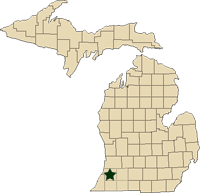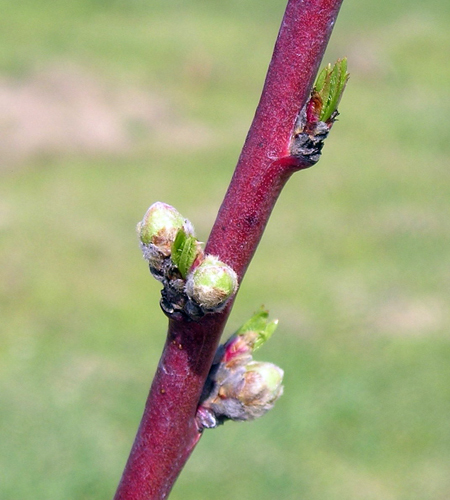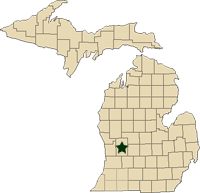Regional reports on Michigan fruit – March 16, 2012
MSU Extension educators’ pest and fruit updates for Michigan.
This week’s regional reports:
- Southwest Michigan - Mark Longstroth, Bill Shane, Diane Brown
- Grand Rapids Area Tree Fruit - Amy Irish Brown and Phil Schwallier
Southwest Michigan – Mark Longstroth, Bill Shane, Diane Brown, Michigan State University Extension
|
A mild winter didn’t harm southwest Michigan’s fruit plantings. Most plants were just waiting for warm weather. Most perennial fruit crops need temperatures above 42°F for growth and we have had lows in the 50s and highs in the 70s. The current heat wave with temperatures about 30 degrees above normal has caused rapid growth in perennial plants in across southern Michigan. This rapid growth should continue next week and will result in plant development being weeks ahead of normal. Winter’s coldest temperatures were on January 15 and February 11 with lows below zero. These cold temperatures caused little damage. The colds temperatures were recorded in lower freeze prone areas.
Cold-sensitive fruits such as peaches and wine grapes are normally planted in high sites where the temperatures were above zero. Soils are saturated with standing water in many blueberry fields. Now is a good time for applying soil active herbicides to control weeds. If you hurry there is still time to get dormant sprays on many fruit plantings. Find a local Enviro-weather station near you.
Tree fruit
Most tree fruit buds are at the swollen bud stage and are moving rapidly with the warm temperatures. Unfortunately, spring freezes are almost a certainty. The stage of bud development will determine how susceptible any given fruit crop is when freezes occur. There are no freezing temperatures in the near future.
Apricot buds have burst and are at red tip. Calyx red has been reported in Berrien County and bloom is likely next week. This would be similar to the bloom date in March 23, 2000.
|
Peaches are past first swell and at calyx green. They are past the dormant copper window to control peach leaf curl. There is still time to apply materials such as ziram or chlorothalonil to reduce leaf curl symptoms.
Sweet cherry buds are plum and round. They are beginning to show green and will open soon. We will soon be well past the window to apply copper to reduce bacterial canker later in the season.
Tart cherries are obviously swollen and showing some green at the tips.
In plums, Japanese plums are well advanced at white side and green cluster. European plums are at the beginning of bud swell.
Apples are moving rapidly past silver and green tip. Exposed green tissue will be susceptible apple scab. Growth is so rapid that growers will need to shorten their spray intervals to cover new emerging leaves. Materials that are recommended for seven to 10 days might need to be applied at three to five day intervals. Growth dilution of systemic fungicides will also require shorter spray intervals. It would be well worth watching the weather and trying to apply protectants as close to wetting periods as possible to get maximum protection from your sprays.
The MSU apple pages have an apple scab page that includes the Mills table for assessing risk from temperature and length of wetness. After and during a rain event, growers can use the scab infection tool on Enviro-weather to track infection periods. The use of copper fungicides at green tip for fire blight and scab control can be tricky in seasons when growth is rapid. Rains following copper application at green tip will usually reduce residue levels to safer levels less likely to cause damage to green tissue after tight cluster – this may not be true if growth is rapid.
Pears are swollen and should break soon. Pear psylla are out.
Small fruit
Grape buds are swollen. Buds of some wine grapes (Chancellor, Vignoles, Chardonnay and Pinot Noir) at the Southwest Michigan Research and Extension Center (SWMREC) are actually further along than juice grapes, but all showing signs of growth.
Blueberry buds are swollen in Van Buren County and unfolding leaves are reported in Berrien County. I expect green tip in the major growing areas by the weekend. Mummy berry infection periods are likely during this warm weather. Growers should scout for mummies and monitor the likelihood of rain and be ready to apply controls for mummy berry. Applications of lime sulfur or Sulfurix now will help reduce phomopsis and anthracnose shoot blight later in the spring during rainy weather.
Strawberries have new leaves emerging from the crown. Now is a good to apply preemergent herbicides for early season weed control.
In brambles, black and red raspberries as well as blackberries are moving and green tissue is showing. Summer bearing plantings should be pruned back as soon as possible, if that has not already been done. The window for the applications of lime sulfur to reduce anthracnose is ending.
Upcoming meetings
There are still some “preseason meetings” planned in southwest Michigan.
- Weather and crop protection workshop on Tuesday, March 20 at SWMREC. Walk-in registration fee for this workshop is $55 and includes lunch.
- Sweet cherry pruning demonstration for trees on Gisela rootstock on March 26 at Fruit Acres Farms.
- Grower update meetings on March 22 and March 29. These updates will address early spring insect and disease control. There is a $5 fee for these meetings.
- Our regular Monday fruit meetings start on April 9 at Fruit Acres Farms at 5 p.m.
Grand Rapids Area Tree Fruit– Amy Irish Brown and Phil Schwallier, Michigan State University Extension
|
Weather update
I’m almost at a loss as to what to say about the weather this year, but it is what it is. In looking at degree day totals for the year so far, we are, of course, very much ahead. Based on data from the Sparta Enviro-weather station, for base 32 we are 14 days ahead, for base 42, which we use for tree growth and some insects, 16 days ahead, and for base 50 for codling moth, 17 days ahead of normal average degree day accumulations. With the forecasted temperatures, especially the warm night temps, we will move even farther ahead of normal through the next week.
For tree growth, a good number to use to guesstimate first green on McIntosh is 110 DD Base 42, but the range is 90 to 130 DD42. By the end of yesterday, Thursday (March 15), we were at about 110 DD42, and we move forward very fast from there. Here’s a prediction of degree days base 42 based on the forecast for the next few days, and please note that we usually get 2 or 3 degree days base 42 per day this time of year – we are getting over 20 per day! Trees are going to develop as fast as they possibly are able.
|
2012 Sparta Wx Station Forecast |
Degree Days Base 42F |
||
|
Today |
YTD |
||
|
Thu |
15-Mar |
22.5 |
112.3 |
|
Fri |
16-Mar |
21.5 |
133.8 |
|
Sat |
17-Mar |
24.5 |
158.3 |
|
Sun |
18-Mar |
23 |
181.3 |
|
Mon |
19-Mar |
23.5 |
204.8 |
|
Tue |
20-Mar |
22 |
226.8 |
As a reference, normal first green for McIntosh (or other mid-season varieties) in the Grand Rapids, Mich., area is around April 11. We will be at least three weeks or more ahead of that this year, and some green in macs were first noticed today on the Ridge (March 15).
Dates of first green on Macs for recent years:
- 2011 – April 12
- 2010 – March 23
- 2009 – April 12
Tasks that need to be done right away include:
- Get brush out of orchards
- Get sprayers up and going
- Put peach leaf curl sprays on right away if not already done.
- Copper applications on sweet cherries should be timed for before or right at bud break - this could happen quickly so don’t wait too long.
- Copper or lime-sulfur applications on apples should be timed for before 0.25 inches green – this could happen very fast this year so don’t wait too long. Some growers on the Ridge are already doing this. The forecast for the next two weeks has no freezing temperatures in it, so copper should be a safe bet for sweets and apples in the next week, as long as that forecast stays the same. Copper on apples will be a good choice for this year due to the low risk of leaf damage with no cold predicted.
- Order insect traps and lures.
- Talk to your bee supplier to be sure you and they are ready early.
Apple scab
I also expect that we will get our first scab infection sometime late next week with rains forecasted. I have my spore monitoring equipment out and will check it with the next rain. Spore development could be delayed somewhat this spring due to little snow cover over the winter. However, the warm winter might offset that. Be ready for scab and don’t miss the first cover sprays – they are important, even with very little foliage present. I’ve seen more problems with apple scab in blocks where the earliest covers were stretched or not applied. If you had problem blocks with scab in 2011, don’t miss these early cover sprays; higher inoculum levels means more risk for scab the next year.
Insects
Unfortunately, the warm weather has also got some insects up and moving. I’ve already splatted three on my windshield in the evenings since Monday night (March 12).
For those with pears, psylla is out on expanding buds and sprays should go on to curb it.
If you are using mating disruption or doing any kind of trap monitoring this year, be sure to get your supplies ordered soon. Disruption for codling moth in apples and pears should be up before bloom in apple, but you can get started on it anytime. Traps for red-banded leafroller can go up soon as well as spotted tentiform leafminer. The warmer nights will get some of these Lepidoptera pests moving.



 Print
Print Email
Email





